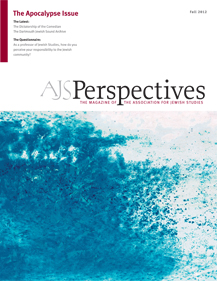
What did scientific and apocalyptic knowledge have to do with each other, and why did they take the stage together? To us, apocalypses seem like the opposite of empiricism and sober analysis—epics of cosmic paranoia that presage both Kabbalistic visions and militant fanaticism. But the maverick historian of religion Jacob Taubes already suggested a different analysis in 1947:
The science of apocalypticism can be defined as the exact numerical calculation of the end of time. It is intended to provide absolute assurance to faith and hope.
Was quantitative precision bound to eschatological vision from the beginning? Close linguistic analysis of the Qumran fragments, when placed in the history of biblical exegesis, helps us to answer this question. A single Aramaic phrase—which, for interesting reasons, appears in no modern translation—connects the history of science, apocalypticism, and knowledge itself in ancient Judaism.
The Bible shows no interest in science: in fact, Deuteronomy (4:19) warns the Israelites about the dangers of astronomy. Conservative attitudes are still reflected in book of Daniel (completed in the second century BCE), which asserts the uselessness of foreign knowledge in comparison to the wisdom God reveals (e.g. Daniel 1:20, 2:19). But already before the Bible’s completion, some Jewish writers were adopting new attitudes toward knowledge of the physical world. By the third century BCE, Biblical patriarchs like Enoch were represented as learning and teaching about numbers and the stars.
Recent scholarship has shown us how the astronomy and mathematics of Enoch derive from Babylonian scholarship, the world’s longest-running empirical scientific tradition. Enoch is not alone: the Aramaic Levi Document, another early visionary work found at Qumran, clearly uses Babylonian mathematics. This was not despised “foreign wisdom”: these scientific works, with their Babylonian roots, were accepted by the Jews of Qumran alongside the Torah and revelations of Moses. By the first century BCE, the Qumran community was drawing on this astronomy to make their calendars. And these texts are only the earliest evidence of a pattern of systematic cosmological speculation in Jewish tradition that continued to evolve through the middle ages in texts like the Pirqei d’Rabbi Eliezer.
Does Judaism enter the history of science here, in a kind of Hellenistic renaissance? To the eminent scholar of Midrash and mysticism, Philip Alexander, these cases of serious interest in mathematics and astronomy suggest the dawn of a kind of scientific thought in Judaism. Alexander has been followed by a set of scholars who convened at New York University last year, to begin integrating early Jewish thought into the history of science—and science into the history of Judaism.
Early Jewish thinkers would have traced systematic knowledge of the universe further back: the Priestly source of the Torah shares, with Babylonian scholarship, an interest in precise categorization and description of the physical world. This interest appears in the creation account of Genesis 1–2:4a, the temple revelation of Exodus 25–31 (cf. Exodus 35–40 and Ezekiel 40–48), and Leviticus 12–15, with its rules for observing physical signs as symptoms of the skin disease sara’at. But the Priestly source does not assume the opposition between nature and culture found in Greek philosophy. God created the universe with the same type of commands that were then transmitted to Moses: rather than an opposition between nature and culture there is a homology between created and commanded.
In the Priestly worldview, the cosmos and the temple are analogous and show a fascinating coherence: “My Sabbaths you shall observe/And my sanctuary you shall revere: I am the Lord” (Leviticus 19:30 and 26:2).
Exodus’s revelation about the temple is a divine speech that specifies the precise measurements

